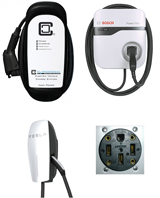How to charge (EVSEs, Receptacles)

You can charge your EV wherever there is electricity.
Most homeowners will opt to install a dedicated "hard wired" box called an EVSE ("Electric Vehicle Supply Equipment") which will have a 20 to 24 foot charging cord to plug into your EV.
Some people are only renting their home, or are traveling and just want to plug into a receptacle. You can purchase EVSEs that come with plugs for this purpose. Note that unless the manufacture has instructions on how to add a cord and plug to a hardwired EVSE, you should not convert a hardwired EVSE to a plug in type. See here for instructions on how to install both hardwired and plug in EVSEs.
While traveling on a long trip, you'll want to charge on the go at a DC Fast Charging station, usually timed for lunch or a comfort stop.
There are a ton of lower power public charging stations that are suitable to recharging over the course of several hours or overnight. These are often useful at hotels, conference locations, work, tourist destinations, and shopping malls.
